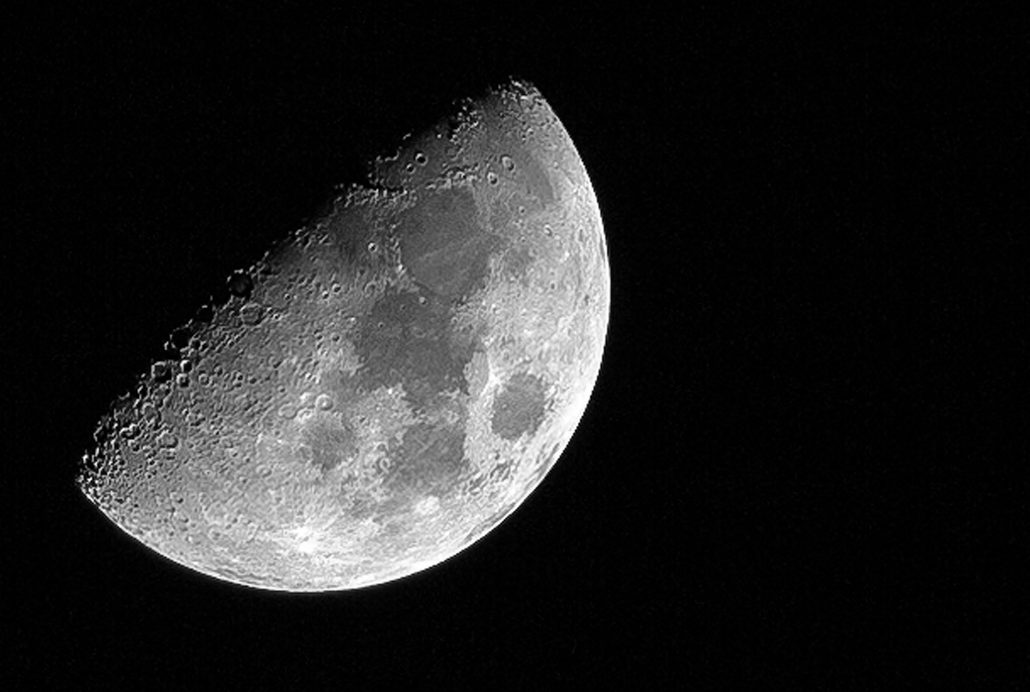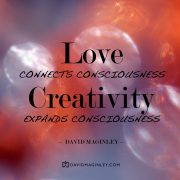Praying? Shoot for the moon!
It was a clear night with a gorgeous moon, yet even with a good lens, my photograph just wasn’t as clear and sharp as I wanted. There were multiple factors at play, among them being automatic camera settings, atmospheric distortion and electronic noise on the camera sensor. I would have to somehow cut through all of them to get the image I needed. It would not be enough just to point the camera and click the shutter.
The first step was to switch to manual focus and exposure; I had to override the camera’s programming and focus on infinity, then tell it to underexpose, otherwise the bright moon would be washed out against the black sky. Second, I set the camera to record RAW files, which contain all the image data, instead of JPEGs, which compress the data. This would give me more control in fine-tuning the image. Third, I used stacking; taking multiple images of the moon and digitally combining them. Stacking software averages out the differences to refine features and improve the signal-to-noise ratio. Finally, I carefully adjust contrast, luminance and clarity in post-production. The result brought out fine details simply not possible with a single, unprocessed shot.
A similar process also improves prayer and meditation, especially in our distracted age. Taking manual control of our thoughts so they don’t automatically focus on whatever wanders onto the mental landscape is the first step. We can also reduce exposure to social media and virtual environments, which have severely compromised our ability to stay focused, and clouded our consciousness with internal noise. All the more with prayer and meditation, where this noise shows up in the form of short attention span, attachment to outcome, the voice of the ego, fear, and doubt. Most of us just ignore all this and compress it into the subconscious (like a JPEG file). Yet that information is critical to deal with in order to achieve the highest state of coherent consciousness. Training and guidance can help us work wisely with these distortions and engage that RAW material in such a way as to improve our clarity and resolution while the noise drops.
Perhaps (like many) you don’t pray except as a last resort, or have dismissed it as an irrelevant superstition from a bygone age. To you I offer this illustration as more than a metaphor, for it’s supported by excellent studies, which you can participate in from the comfort of your own home. Pioneers like Lynn McTaggert, and organizations like the Institute of Noetic Sciences run prayer and intention experiments, exploring how spirituality is more than faith in a creator. It is active participation as spiritual beings to be the agents of change this world needs.
This is consistent with the teachings Christ, who seemed to emphasize group prayer as the preferred method for his followers. (Of the 37 instances in which he refers to prayer, 33 of them were addressed to a plural rather than singular audience.) He instructed them to focus their consciousness with homothumadon, a Greek musical term denoting resonance or harmonious vibration. In this state, when more than one was gathered, the spirit would be among them. This is not to say you should not pray alone! Jesus always encouraged private prayer as a continual connection with God. However, he emphasized even more the importance of focusing that energy in a group. Something about the group experience was critical in shifting the effect to result in real change for the community.
This is also, of course, what the church has been teaching for centuries – but in a doctrinal context increasingly out of step with modern understandings of consciousness and the nature of non-local mind. (And, it’s important to note that it is not being “Christian” that activates this, but shifting your consciousness to manifest love. That’s what it means to “pray in Jesus name”.) No wonder so many underestimate the power of prayer, or dismiss it altogether.
I like the contemporary lens of quantum consciousness, which can renew our curiosity about prayer, demonstrating how thoughts and expectations will dramatically affect the reality we experience (even retroactively). As an individual, this manifests on the subatomic and personal level. As a community, the impact is exponentially greater.
It’s long been known that mind is non-local – thoughts, feelings, and intention all have energy, which affects the local environment. Meditation has also been shown to rewire your brain, configuring you for equanimity and resilience. So, while your thoughts and prayers may seem insignificant, they ripple out to touch distant shores. Your energy, your consciousness, has an effect on the world – the challenge is amplifying your impact to make an intentional difference. The solution is nothing new, part of spiritual instruction dating back millennia.
Whether you’re praying for a loved one facing cancer, or meditating for peace in a society that desperately needs healing, I encourage you not to abandon hope, faith and love, but to activate them like never before. Do this by taking 3 steps to deliberately tune your consciousness:
- Focus by reducing your exposure to so many distractions. In the evening, turn off your phone and media devices, and take 10 minutes for silent mindful presence.
- Process the RAW material of your soul through compassion, counselling and forgiveness.
- Stack your prayers or meditations with others, either online or (better) in person. (I know there’s a bunch that usually get together on Sundays!)
I truly believe prayer initiates action that will change the world. That may seem a lofty goal, but together, we really can shoot for the moon.
In my next post, we’ll explore the delicate matter of wanting a prayer to “work” and trying to do it “right.”
Question: With this new model of consciousness, what one step would you take to focus meditation or prayer?





Homothumadon a Greek musical term denoting resonance or harmonious vibration.”
I have not heard that term before, but it rings true with our definition of Spirituality used in Horizon Health in New Brunswick. SONG … spirituality is about Self Other Nature God. This was taken from research done by a group of professors at the St.FXU School of Business. They were doing research on the spirituality of work but could not find a common definition so they refocused their research on what is spirituality?
Without getting into a long response, I find SONG is very much in harmony with Homothumadon. We all have our unique SONG at times in harmony with others and at times in dissonance ‘the diablos of music” the devil of music … the tritone. But it is sharing out unique music that we give life, give compassion to others.
I thank-you for your reflection.